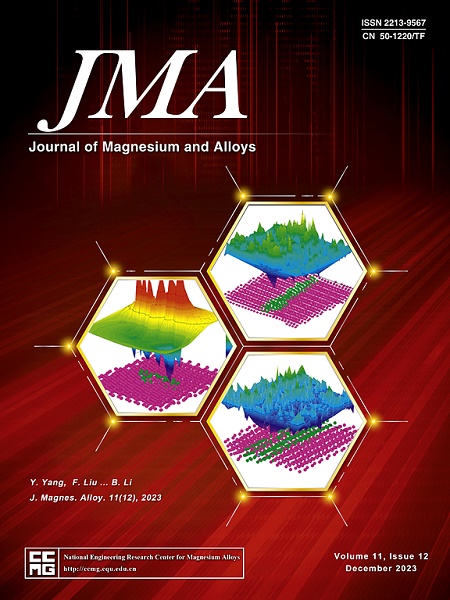Very high cycle fatigue resistance improvement of Mg-Gd-Zn-Zr alloy by introducing curved long-period stacking ordered lamellae
IF 15.8
1区 材料科学
Q1 METALLURGY & METALLURGICAL ENGINEERING
引用次数: 0
Abstract
Magnesium alloys with long-period stacking ordered (LPSO) structures are known for their impressive static mechanical strength, but the consistent occurrence of slip-cracking along the LPSO lamellae, which do not effectively impede the movement of basal dislocations, has prompted concerns about their very high cycle fatigue (VHCF) performance. In this study, an extruded Mg-Gd-Zn-Zr alloy was developed, showcasing exceptional VHCF resistance due to its bimodal structure comprising fine grains and coarse grains consisting of curved LPSO lamellae. The investigation on the crack initiation mechanism revealed that slip-induced cracking predominantly occurs in fine-grained regions rather than in the interior of coarse grains. The extrusion process aligns the basal planes of most coarse grains parallel to the axial direction, and the presence of curved LPSO lamellae acts as barriers to the movement of basal dislocations, thereby effectively increasing the threshold for slip-cracking along the basal plane. Consequently, fatigue damage manifests in the form of slip bands and micro-cracks within the interior of fine grains, ultimately resulting in fatigue crack initiation, propagation and final fracture.

通过引入弧形长周期堆叠有序薄片提高镁-钆-锌-锆合金的超高循环抗疲劳性
具有长周期有序堆积(LPSO)结构的镁合金以其令人印象深刻的静态机械强度而闻名,但是沿着LPSO薄片持续发生的滑移开裂,不能有效地阻止基底位错的运动,引起了人们对其非常高的循环疲劳(VHCF)性能的担忧。在本研究中,开发了一种挤压Mg-Gd-Zn-Zr合金,由于其由弯曲的LPSO片组成的细晶粒和粗晶粒组成的双峰结构,具有优异的抗VHCF性能。对裂纹起裂机理的研究表明,滑移裂纹主要发生在细晶区域,而不是在粗晶内部。挤压过程使大多数粗晶粒的基面与轴向平行,弯曲的LPSO片层的存在阻碍了基面位错的移动,从而有效地提高了基面滑移开裂的阈值。因此,疲劳损伤表现为细小晶粒内部的滑移带和微裂纹,最终导致疲劳裂纹的萌生、扩展和最终断裂。
本文章由计算机程序翻译,如有差异,请以英文原文为准。
求助全文
约1分钟内获得全文
求助全文
来源期刊

Journal of Magnesium and Alloys
Engineering-Mechanics of Materials
CiteScore
20.20
自引率
14.80%
发文量
52
审稿时长
59 days
期刊介绍:
The Journal of Magnesium and Alloys serves as a global platform for both theoretical and experimental studies in magnesium science and engineering. It welcomes submissions investigating various scientific and engineering factors impacting the metallurgy, processing, microstructure, properties, and applications of magnesium and alloys. The journal covers all aspects of magnesium and alloy research, including raw materials, alloy casting, extrusion and deformation, corrosion and surface treatment, joining and machining, simulation and modeling, microstructure evolution and mechanical properties, new alloy development, magnesium-based composites, bio-materials and energy materials, applications, and recycling.
 求助内容:
求助内容: 应助结果提醒方式:
应助结果提醒方式:


